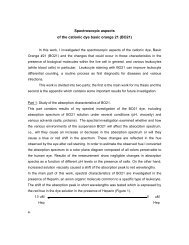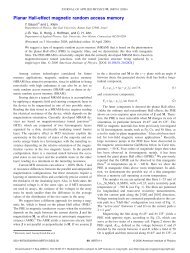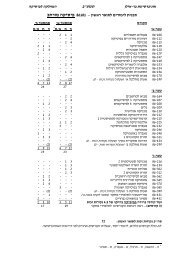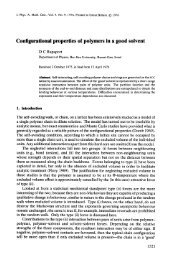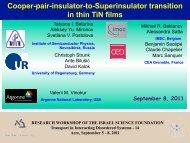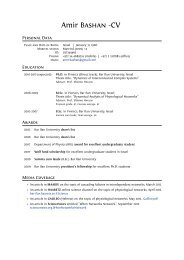Elementary excitations and avalanches in the Coulomb ... - PhysioNet
Elementary excitations and avalanches in the Coulomb ... - PhysioNet
Elementary excitations and avalanches in the Coulomb ... - PhysioNet
You also want an ePaper? Increase the reach of your titles
YUMPU automatically turns print PDFs into web optimized ePapers that Google loves.
obust <strong>and</strong> does not require f<strong>in</strong>e tun<strong>in</strong>g. In fact, we observe a divergent cutoff for o<strong>the</strong>r valuesof of K near 1/2, when perform<strong>in</strong>g hops<strong>in</strong><strong>in</strong> orderof of <strong>in</strong>creas<strong>in</strong>g hopp<strong>in</strong>g length <strong>in</strong>steadof of uniformlyat at r<strong>and</strong>om, <strong>and</strong> even for huge disorder (W = 32).Avalanche distribution for dipole <strong>in</strong>sertionp(S) p(S)10 10 -2 -210 10 -3 -310 10 -4 -410 10 -5 -5W =2L L = = 8816 1630 3060 60! S -3/2A(a,L) L 3/2 3/2 p(S)10 10 0010 10 -1 -110 10 -2 -210 10 -3 -3L L = 8816 1630 3060 60(2 (2") ") -1/2 xx -3/2 exp(-x/a)a = 0.4810 10 -1 -1 10 10 00 10 10 11 10 10 2210 10 11 10 10 -1 -1 10 10 00SS // LFigure cutoff 3. 3. diverg<strong>in</strong>g Avalanche l<strong>in</strong>early size distribution with L scale free Figure p(S) 4. ∼ Scal<strong>in</strong>g S −τ extrapolat<strong>in</strong>g plotof of <strong>the</strong> avalanche to L = ∞for dipole-triggered <strong>avalanches</strong>.Thesize distribution assum<strong>in</strong>g Eq.(5) withdata are averaged over 20000, 48000,τ = 3/2 <strong>and</strong> S c c = aL. A(a, L) is isp(S) ∼ S −τ exp(−S/S 29000, 2135 samples for L =8, 16, c ) τ ≃ 1.530, 60a normalization Consistent factor with slowly mean-fieldvary<strong>in</strong>grespectively. S with L, exponent computed analytically τ =3/2from <strong>the</strong>c = aL a ≃ 0.5branch<strong>in</strong>g process model.normalization:also Although well fitted <strong>the</strong>se by results p(S) may ∼ Ssuggest −τ exp[−(S/S an analogy c ) 2 ]with <strong>the</strong> self-organizedA(a, L) critical=λ(L)/(1 <strong>avalanches</strong>− e −λ(L) ) of of<strong>the</strong> SK model, we argue that <strong>the</strong>y τ ≃ 1.7 can be understood more simplyλ(L) <strong>in</strong> <strong>in</strong> terms − 1 −of of ln λ(L) <strong>the</strong> elementary = (aL) −1



